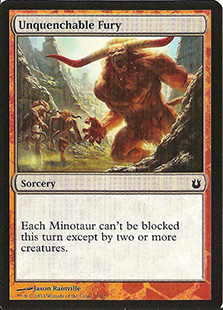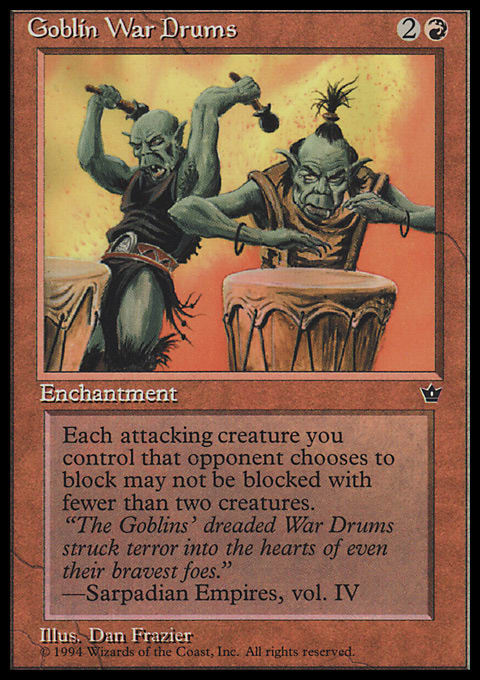Figuring out wacky ways to use Magic cards is one of my favorite ways to play the game. I’m not a tournament player, so I typically become more excited about the multiplayer summer expansions than traditional expansion sets. Gimme Planechase, Commander, and Duel Decks over a standard Event Deck any day of the week. (Am I alone in this, or are there others out there who are like I am?)
It’s fun to incorporate strange cards into formats where they don’t really belong. That’s our task today. I’d like to look at different ways we can use cards from the recently-released Face the Hydra and Battle the Horde decks, which are part of the Hero’s Path Game Day events. Designer Dave Guskin has said a couple of times that cards in these decks are “not Magic cards,” but I don’t think that should stop us. Sure, they have different card backs, and they lack casting costs. But this is Magic! It’s nothing if it’s not customizable.
Our only limitation is our imagination.
Hero’s Path Cards and the Chaos Deck
The Chaos Deck variant is perhaps the easiest format to start with. Since the converted mana costs of Chaos Deck cards don’t typically matter, slipping Hero’s Path cards into a Chaos Deck should be relatively easy. All you need to do is put your Chaos Deck in sleeves with an opaque back, and you’re off and running.
Noxious Hydra Breath is a perfect edition to any Chaos Deck. It gives your group a painful choice to make. The fact that the second ability refers to each “non-Head creature” is nice, too. Basically, it will destroy every tapped creature on the battlefield.
Intervention of Keranos is another good option. Because of the way the rules text is phrased, its effect can be applied to game play pretty easily.
 | 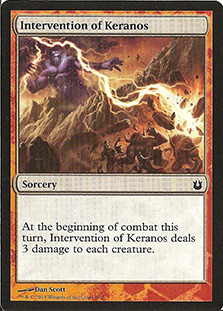 |
Some of the sorceries from the Face the Hydra deck might also work, as long as your group is willing to interpret the word “Heads” as “creatures” and think of the Chaos Deck as being “the Hydra.” For example, Unified Lunge would read, “Unified Lunge deals X damage to each player, where X is the number of creatures on the battlefield.” And Disorienting Glower could be interpreted as, “Players can’t cast spells until the next time a Chaos Deck card is played.”
Similarly, you could include some of the sorceries from the Battle the Horde deck by swapping out the word “Minotaur” for “creature.” Consuming Rage would then read, “Whenever a creature attacks this turn, it gets +2/+0 until end of turn. Destroy that creature at the end of combat.”
This type of play requires your group to be open to interpreting rules text. This may not work for every group. Use your discretion and stick to stuff you know will be fun for your group.
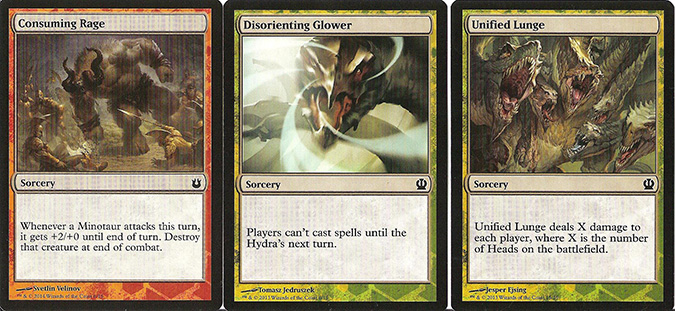
One last idea for the Chaos Deck: It might be cool to include the artifact cards from the Battle the Horde deck and the Head cards from the Face the Hydra deck as reward cards for players.
For example, when Vitality Salve is played from the Chaos Deck, it could go onto the battlefield as an artifact that no one controls. Its first ability would resolve by flipping over another card from the Chaos Deck. If Vitality Salve is still on the battlefield, it can then be controlled, destroyed, stolen, Unsummoned, or just ignored. Essentially, it’s a distraction from the battle that will reward someone if it is destroyed. Once it’s destroyed, the second ability resolves rewarding either just the active player—or every player, depending on how your group wants to play.
The same thing could be done with the Heads from the Hydra deck.
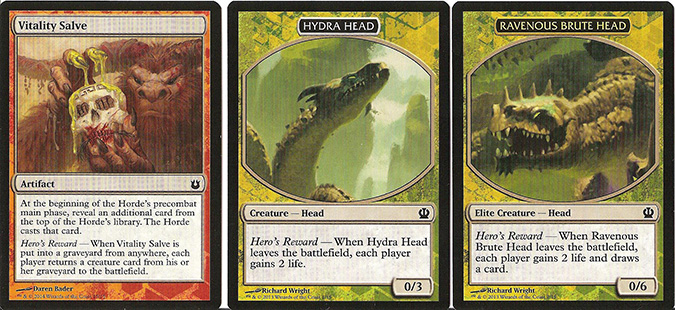
Cube Drafting
Similar to the Chaos Deck, it might be possible to include a number of the Hero’s Path cards in a Cube list if the other players are willing to make substitutions to the rules text on the cards. If they are willing to swap out “Minotaur” for “creature,” Unquenchable Fury becomes the sorcery version of Goblin War Drums for free.
Rather than mix the Hero’s Path cards right into your Cube, another idea would be to do a separate Draft of just those cards in addition to your normal Cube Draft. So, for example, after your group does a regular Draft, you do a Draft of mini-packs that contain just two or three of the Hero’s Path cards. This mini-Draft would be a fun bonus to your normal Draft since every card would be castable by any player, regardless of the colors he or she drafted. Or you could even just hand out Hero’s Path cards to each player at random. Either way, players end up with a unique bonus.
If casting sorceries for free is just too much power, consider treating each of the Hero’s Path sorceries as colorless cards with mana costs of 0, 1, 2, or 3 colorless mana, depending on what your group is comfortable doing. I think it would work well to make each sorcery cost ![]() and to think of them as uncommons or rares. This puts them in roughly the same spot as staples such as Pyroclasm, Regrowth, and Demonic Tutor.
and to think of them as uncommons or rares. This puts them in roughly the same spot as staples such as Pyroclasm, Regrowth, and Demonic Tutor.
Commander
It would be possible to slip Hero’s Path cards into Commander decks in similar ways to what we’ve already described. But I think Commander should be treated uniquely. Commander is a format that works best with a lot of players and big, big plays. Also, a lot of Commander players create theme-heavy, story-laden decks. It’s seems too easy to just slip the new cards into the game without any special consideration to the ethos of Commander games. So how can we use the Hero’s Path cards in a way that adds to the Commander experience?
One idea would be to bring the decks into the game as a surprise extra player, a new opponent that forces everyone to temporarily team up. For example:
Imagine you sit down with three friends to have an all-player-for-themselves Commander game. Before the game, you all agree that once someone reaches 30 or less life for the first time, the Battle the Horde deck enters the game. (Flavorfully speaking, you could say that the minotaurs smelled blood and followed the scent to the battle.) Once the Horde enters play, it’s everyone against the minotaurs. Once they are eliminated, the game returns to normal play, and the horde is never heard from again. You could do the same thing the first time someone reached 20 life with the Hydra deck.
Think of Star Trek into Darkness or X2. In both movies, the heroes and villains had to team up at one point in order to defeat a mutual enemy. Once that enemy was defeated, they were back at each other’s throats. That’s what I’m going for here.
What about the Hero Cards?
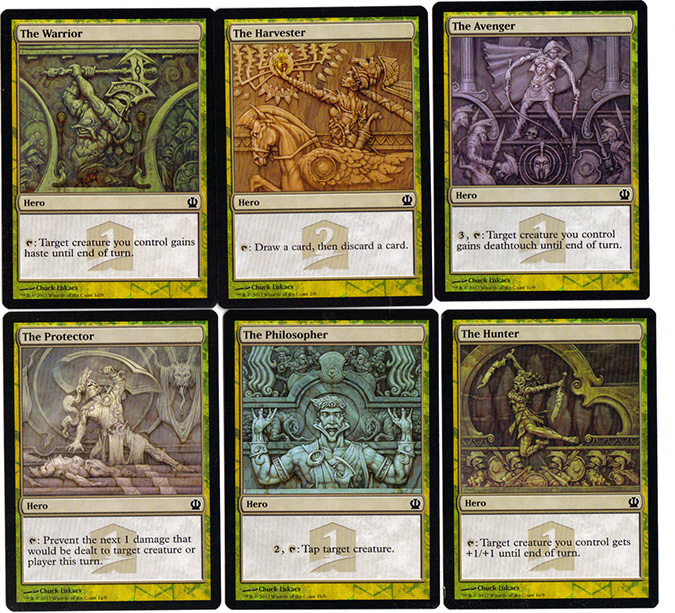
It is probably simplest to use Hero cards in other formats by treating them all as 0/1 colorless creatures with a converted mana costs of 0. Used this way, they’re not that different than Ornithopters, Kobolds, and the other free creatures in Magic.
One way to use Heroes would be to play with them in a regular game like the old Vanguard cards (starting the game on the battlefield, giving you a bonus) but then treat them like creatures you control. They can be targeted, stolen, placed in the graveyard, or placed in your hand just like any regular creature card.
It would be like starting the game with a Memnite on the battlefield. Imagine enchanting The Slayer with Rancor on turn one and swinging. You now have a 9-point lead on your opponent. Or if you started the game with The Warrior on the battlefield: Until he dies, you can give one creature haste every turn, even on turn one.
A Hydra of Ideas

What ideas do you have? How will you use the Hero’s Path cards in other formats?
Do you like or dislike the options I’ve listed here? How would you tweak them? Leave your thoughts below. Let’s carve some new paths, heroes.
















